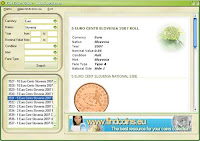The money is not just an exchange tool, but as a symbol of civilization too (politics, culture, and era). Therefore, money has multifunction. If we read the development of a currency, we can tell a story about the condition of a nation and all of the civilization journey history.
The journey of Indonesia history could be seen on the currency too. The Kindom of Djenggala (856-1158 M) is the first kindom which use currency (9th - 12th century). In 7th century, it's known that at the first time the currency made from silver in semi circular (half-circle) form. There is the carved of vase and billowing smoke on its face. On the back, the carved of Padma flower at the center of a frame.
Except to half-circle form, there are coins in the rectangular and button form which carved with ancient Javanese character.

In the Djenggala era at Kediri which known as the oldest kingdom on Java Island, the money was called by name "Krishnala". The money was made of silver and bronze. In the Majapahit era, the money was known by name "Gobog", looks like the Chinese gobog. Form in thin-circle and there was a rectangle hole at its center. In general, the Gobog money has carved of animal, puppet, and the relief which symbolize a people tale on that time.

There is more in the Kingdom of Banten, the currency which has the form as like as the Majapahit's Gobog money. In the Kingdom of Sumenep, the money called by name "Real Batu". That money supposed come from the Kingdom of Spanish's currency, but modificated by put a stamp of Arabian character "Soemenep", "Number" or "Rose flower".
At the Kingdom of Gowa, South Sulawesi, the Dinar money which made of gold was known in the Sultan Hasanuddin era (17th century). It's look like the Derham Aceh. In Banjarmasin, known as "Doewit" and circulating around year 1812, made of tin.
The currency which mold by the Kingdom of Buton, has difference to the other kingdom currencies, because it doesn't use metal, but fabric material which weaved by the king daughter. It's popular by name "Kampua" or Bida".
Labels: banten, coins, kingdom, majapahit




















